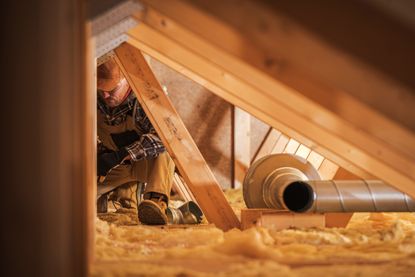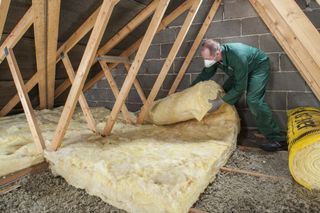Home insulation grants: can you get help paying for loft and cavity wall insulation?
Home insulation grants can help you afford loft and cavity wall insulation which could save up to £1,060 per year on energy bills. We tell you who can do it, how and what financial support is available


Home insulation grants can help you get loft and cavity wall insulation, potentially saving you more than £1,000 on your annual energy bills.
Winter is approaching and even with the government’s ‘energy price guarantee’, keeping bills down is a priority for many households in the face of rising inflation and costs.
But you can save costs by keeping the heat in your home with loft and cavity wall insulation.
Here we explain how much insulation can save you, what grants are available to help pay for it and how you can insulate your own home.
Home insulation grants
What difference can home insulation make to your bills?
A quarter of heat is lost through the roof if not insulated, Energy Saving Trust explains. This is the case with all types of roofs including sloped, flat or loft space.
According to EDF, both cavity wall and loft insulation can save you up to £1,060 per year on energy bills.
Cavity wall insulation
If we break it up into the type of home you live in, here’s how much you could save annually if you get cavity wall insulation alone, according to Energy Saving Trust:
Look After My Bills Newsletter
Get the best money-saving tips, tricks and deals sent straight to your inbox every week. Make sense of your money in partnership with The Money Edit.
| TYPE OF HOUSE | ANNUAL SAVING (£) |
|---|---|
| Detached house | £480.00 |
| Semi detached house | £285.00 |
| Mid-terrace house | £180.00 |
| Detached bungalow | £195.00 |
| Mid-floor flat | £145.00 |
These figures are based on the current energy price cap of £1,971 set by Ofgem.
Loft insulation
Energy Saving Trust also worked out how much you could save annually if you get 270mm of loft insulation:
| TYPE OF HOUSE | ANNUAL SAVING (£) |
|---|---|
| Detached house | £580.00 |
| Semi detached house | £255.00 |
| Mid-terrace house | £230.00 |
| Detached bungalow | £365.00 |
Before looking into it, you should also check if your home needs loft or cavity wall insulation as it depends on how old your house is and its wall type.
For example, Energy Saving Trust says houses built after the 1920's are likely to have a cavity wall, which are 2 walls with a gap, the gap being the ‘cavity.’ Houses before this time might have a solid wall, in which case you don’t need cavity wall insulation.
What home insulation grants and support is available?
The Energy Company Obligation (ECO) scheme, means there are grants available to insulate your home.
Big energy firms like British Gas, E.ON, Scottish Power and Octopus Energy are taking part in the ECO scheme, and they are offering to insulate your roof and cavity wall for free (subject to terms). You can find yoru firms contact details on the Ofgem website
The government says you could be eligible if you live in private housing (for example you own your home or rent from a private landlord) and get one of the following benefits:
- Child Tax Credit
- Working Tax Credit
- Universal Credit
- Pension Guarantee Credit
- Pension Savings Credit
- Income Support
- income-based Jobseeker’s Allowance (JSA)
- income-related Employment and Support Allowance (ESA)
- Child Benefit
- Housing Benefit
The energy rating of your home also matters.
- If you own your house, it must have an energy efficiency rating of D, E, F or G to be eligible.
- If you rent from a private landlord, the house must have an energy efficiency rating of E, F or G to be eligible. You must have the owner’s permission to do the work.
- If you live in social housing that has an energy efficiency rating of E, F or G you might also be eligible for help with insulation or installing a heating system for the first time.
You can use the energy performance certificate register to find your property’s energy efficiency rating, or ask your landlord.
The criteria includes the homeowner must be claiming benefits which is listed on the government website, and it depends on the energy efficiency rating of your home.
Who can do roof and cavity wall insulation?
Energy Saving Trust advise that cavity wall insulation is not something you can do yourself and you should get a professional in to do the job, someone who is registered. For a detached house, having cavity wall insulation put in costs around £610.
To find some trustworthy to carry out the work, you should look out for a tradesperson who is a member of one of the following:
- The Cavity Insulation Guarantee Agency
- The National Insulation Association
- The British Board of Agrement
When it comes to loft insulation, if you have easy access and there is no condensation or damp issues, then you could do it yourself, saving you money in the short term and long term.
If you prefer to get a professional in to do the loft insulation for you, then you can do so. It’s good to check that they are part of the National Insulation Association to ensure they are trustworthy.
Whether you’re looking for a tradesperson to do loft insulation or cavity wall insulation, you can also check on the Trustmark website to see if they are trusted by the government.
Labour costs average around £250 per day. Depending on the type of roof insulation you want, material costs can vary between £10 to £40 per square metre, according to Checkatrade.
Can you insulate your loft yourself?
Yes. It’s a relatively straightforward DIY task for a fit and healthy person.
DIY retailer Wickes recommends you first, clear the loft to ensure you have a safe working space.
- Lay walkboards on the loft ground so you can use it to walk across, lean on and place the insulation on.
- Then, measure the insulation roll and the space between the loft joists and cut the roll according to the size of the gap. You usually get 400mm or 600mm roll sizes.
- Once cut, put the insulation down covering the walkboards. Start from the furthest corner and make your way to the loft hatch. It’s important that you have to squeeze the insulation in with a ‘friction fit’ so there are no gaps, otherwise heat can be lost.
- Also remember not to press down hard on the insulation as this can reduce how well it insulates. It's good to keep any off cuts you have to fill any small spaces.
- Once the first layer is complete, unroll the second layer over the top of the first (which doesn’t need to be cut to any particular size, as long as it’s covering the first layer).
- Lastly, don’t forget to insulate the loft hatch.

Insulation problems to look out for
After having loft or cavity wall insulation installed, new or old problems can occur. You may find dampness after a loft or cavity wall insulation.
This can be for several reasons, a damp problem could have occurred at the time of the installation, the house might not be right for the measured insulation, the insulation wasn’t done correctly or there might have already been a damp problem that was never resolved.
Energy Saving Trust recommends that if you can’t put your finger on the problem, then you should look out for damaged/ blocked gutters, missing slates or tiles, damaged bricks, plumbing leaks or excessive moisture.
Spray foam insulation has been a popular choice in recent years to cut energy costs. As many as 250,000 homes have spray foam insulation in lofts, roofs, walls and floors to improve the property’s energy efficiency, according to the Property Care Association.
But because the spray foam industry is unregulated, the concern is growing among industry experts and mortgage lenders that cowboy traders are not installing it correctly, not using the right foam nor checking if it is right for the property.

Vaishali graduated in journalism from Leeds University. She has gained experience writing local stories around Leeds and Leicester, which includes writing for a university publication and Leicester Mercury.
She has also done some marketing and copywriting for businesses.
When she is not writing about personal finance, Vaishali likes to travel and she's a foodie.
-
 Three energy firms pay £8m in switching compensation - has your provider paid out?
Three energy firms pay £8m in switching compensation - has your provider paid out?More than 100,000 customers have received compensation after changing providers, but is now a good time to switch energy suppliers?
By Tom Higgins Published
-
 Save £300 on your supermarket shop with cashback accounts
Save £300 on your supermarket shop with cashback accountsBanks, credit card companies and cashback sites are all offering cashback on your supermarket shop, but can you use them all to max out your savings?
By Vaishali Varu Published
-
 Three energy firms pay £8m in switching compensation - has your provider paid out?
Three energy firms pay £8m in switching compensation - has your provider paid out?More than 100,000 customers have received compensation after changing providers, but is now a good time to switch energy suppliers?
By Tom Higgins Published
-
 HMRC tax credit renewal packs: act quickly to avoid losing benefit payments
HMRC tax credit renewal packs: act quickly to avoid losing benefit paymentsHouseholds receiving tax credits will be asked to confirm their details to ensure they continue to receive their entitlement. Here’s everything you need to know to make sure you don’t miss out on up to £3,480 a year
By Tom Higgins Published
-
 Mobile provider rewards: how to earn up to £700
Mobile provider rewards: how to earn up to £700Your phone could be the key to unlocking hundreds of pounds worth of discounts and freebies that you don’t even know about. We reveal which mobile providers offer the best rewards
By Vaishali Varu Published
-
 How much do cooking appliances cost to run?
How much do cooking appliances cost to run?Energy-saving cooking tips from the Energy Saving Trust
By Katie Binns Published
-
 Virgin Media leaves thousands without broadband: are customers entitled to compensation?
Virgin Media leaves thousands without broadband: are customers entitled to compensation?Tens of thousands of Virgin Media customers were hit by broadband outages yesterday. We explain your rights if your broadband goes down
By Katie Binns Published
-
 Broadband switching service delayed - how it will eventually work and why it’s crucial to switch
Broadband switching service delayed - how it will eventually work and why it’s crucial to switchA broadband switching service designed to make it easier to change to a cheaper or faster deal has been delayed. We explain how you can still avoid huge increases to your monthly internet bill
By Katie Binns Published
-
 Heat pumps: why you can claim a £5,000 government grant for longer
Heat pumps: why you can claim a £5,000 government grant for longerWhy you now have more time to apply for a government grant towards getting a heat pump in your home
By Sue Hayward Published
-
 British Gas cuts energy bills by £15 for prepayment meter customers from April
British Gas cuts energy bills by £15 for prepayment meter customers from AprilOne million British Gas customers on energy prepayment meters will save around £15 as British Gas cuts its penalty three months early
By Sue Hayward Published